There's so much to see on Ko-Sichang that we're still discovering new attractions after twenty years of visits and five years of living here.
There's hardly a corner of the island where you won't find something worth looking at. Below we list the most popular targets, plus a couple that are often overlooke, but shouldn't be. Samlors will take you to most of these on the standard tour of the island. Make sure to allow plenty of time--just tell the driver how long you want to wait, and it's her/his call whether to wait, or go off and come back.
Don't forget to pick up a copy of our Island Welcome brochure for a map, or download the Adobe Acrobat .pdf map from the site.
Rama V (King Chulalongkorn's)
Palace
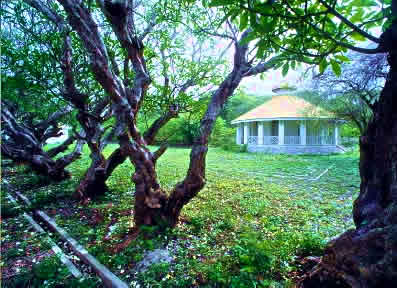
![]()
Built starting about 1890, the Judhadhut Palace was abandoned shortly after
hostilities with France in 1893 showed how vulnerable it was to a modern navy.
The main building was taken to Bangkok, where it is now famous as Vimarn Mek
palace.
Several of the remaining structures have been
restored. A walk through the gardens and up the hill under century-old frangipani
trees can be a delightful way to spend an hour or two, especially in the late
afternoon. For the determined explorer, there are hard-to-find staircases
down to the see, a couple of caves with almost-safe staircases leading down
into the darkness, a rock that rings like a bell when you hit it, and the
architecturally unique Asdangkhanimit temple (conical white structure up on
the hill).
Chinese Temple (Saan
Chao Pho Khao Yai)
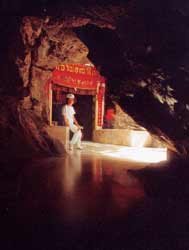
![]()
North of the town, very
conspicuous as you approach on the ferry, is the Chinese temple known as Saan
Chao Pho Khao Yai, or Shrine of the Father Spirit of the Great Hill. This
predates the palace by centuries, going back to the days when junks from Ming
China anchored in the sheltered water on the east side of the island. The
shrine, founded around a cave from which seafarers saw a magic light shining
into the night, draws tens of thousands of mainly Chinese supplicants from
as far away as Djakarta and Beijing.
Yellow
Buddha - Tham Chakrabongse
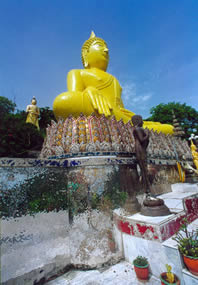
Just north of Wat Tham Yaai Prik, uphill behind the bank, prominently visible if you come in on a daytime ferry, is the Tham Chakrabongse meditation center. There you will find three colossal Buddha images, and can go down the hill through a cave of modest interest. A walk uphill over the saddle behind the images will bring you to a secluded little valley facing the sea.
Wat Tham Yaai Prik
This unorthodox (nuns wear brown, and everybody works) Buddhist community offers a pleasant walk through shady gardens, sweeping views of both sides of the island, chapel caves, meditation cells in the rock, and a chance to talk to some of the monks and nuns. You can get a short and clear explanation of Buddhism, or arrange a multi-day meditation course. A donation may be suggested, but the decision is entirely yours.
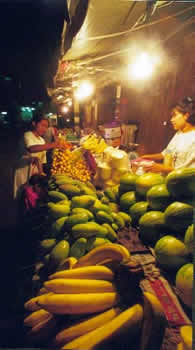 Old Town
/ Night Market
Old Town
/ Night Market
Few people explore the maze of tiny alleys around the pier below the Chinese Temple. This is where you will get the best feeling for what Ko-Sichang was like in the old days (until 1953, not a single fishing boat had an engine). At night there are a variety of stalls open throughout the town, usually until very late indeed.
Buddha's
Footprint
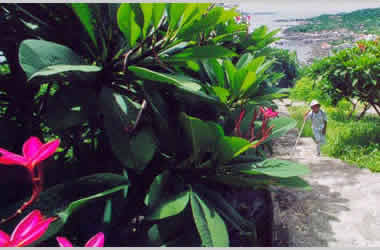
In a little
gazebo about 100 meters above the main shrine of the Chinese Temple is the
Buddha's Footprint. If you have the energy for a fairly stiff climb, the
ideal approach is to go up the rear or western stairway early in the morning.
After 505 stairs you step suddenly from close bush to a panoramic view of
the harbor and Siracha on the mainland, spectacular at sunup. An improvised
walking stick is handy for the steeper parts and for making yourself understood
by any stray dogs that might claim the stairs for themselves. Ring
the big bell three times (hit it moderately hard with the stick provided)
to let the spirits know you have come to pay homage.
Sunsets
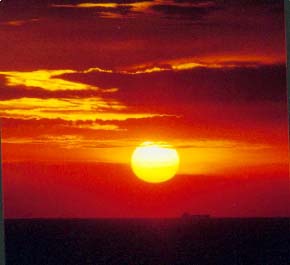
What kind of trip to a tropical island could leave out watching the sun set over the sea? Thanks to its many high headlands, Ko-Sichang offers especially good views. Three of our favorite spots are the clifftop patio at Sripitsanu Bungalows (beer close by), and the headlands at Tham Pang and Khao Khad, where you can pick up your cold drink from the Sichang View restaurant and stroll out across the pedestrian bridge to the very tip of the cape.